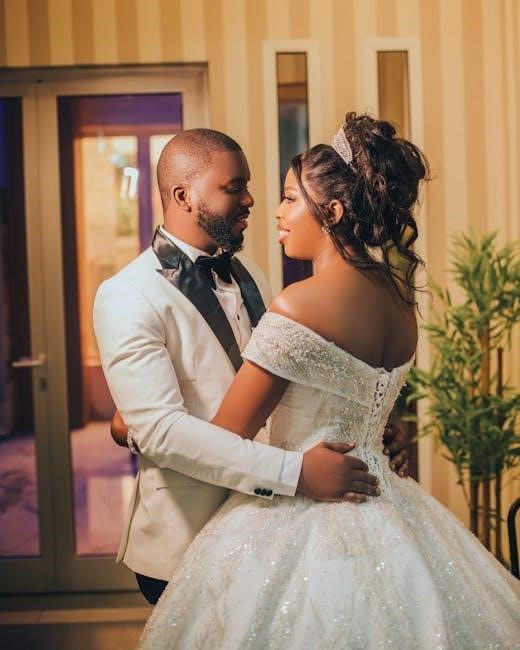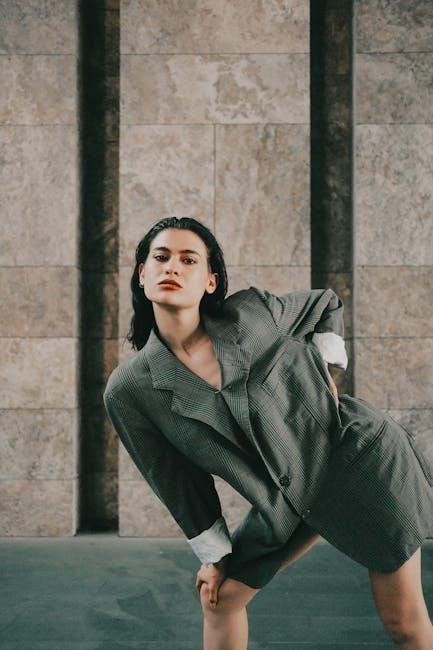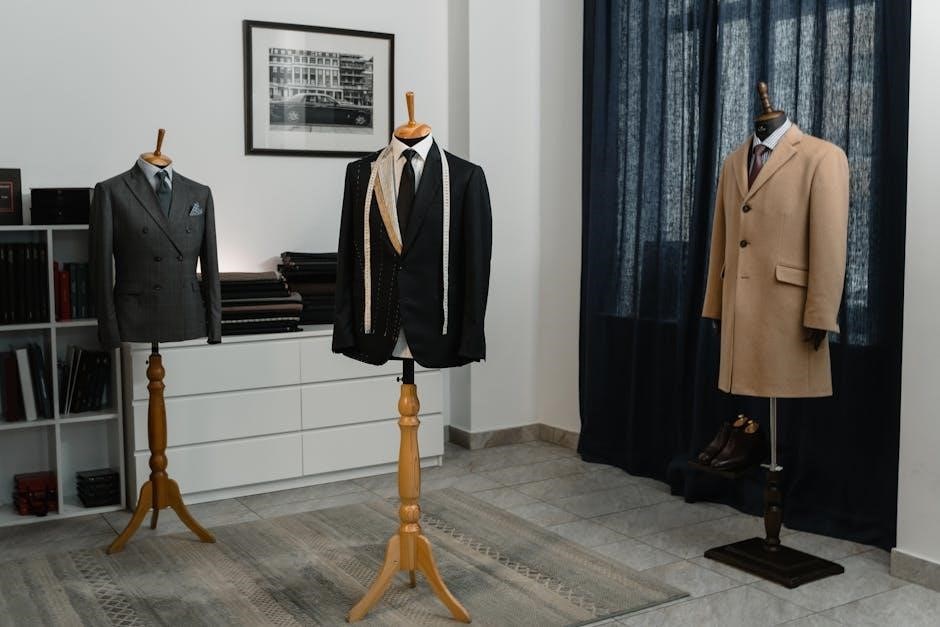A well-fitting suit jacket is essential for a polished look, ensuring comfort and confidence. Proper sizing involves understanding key measurements like chest, sleeve, and jacket length, while considering personal style preferences to achieve the perfect fit.
1.1 Importance of Proper Fit
A proper fit is crucial for both functionality and aesthetics. A well-fitting suit jacket enhances confidence, creating a polished and professional appearance. It ensures optimal comfort, allowing freedom of movement while maintaining a streamlined silhouette. Improper fit can lead to discomfort and a less flattering look, making it essential to prioritize accurate measurements. Addressing common issues like shoulder gaps or sleeve length discrepancies ensures a tailored finish. Investing time in understanding sizing and style preferences guarantees a jacket that not only looks great but also feels exceptional, making it a worthwhile investment for any wardrobe.
1.2 Brief Overview of Sizing Considerations
Sizing considerations for suit jackets involve evaluating key measurements and personal preferences. Chest size is fundamental, ensuring the jacket button closes comfortably without strain. Sleeve length should align with shirt cuffs, while jacket length ideally covers the hip. Shoulder fit is critical to avoid gaps or restrictions. Fabric type impacts fit, as thicker materials may require slightly larger sizes. Style differences, such as slim-fit or classic cuts, also influence sizing choices. Each brand may have unique standards, so comparing size charts is essential. Understanding these factors ensures a jacket that balances comfort, aesthetics, and functionality, catering to individual body types and style preferences effectively.

Understanding Key Measurements
Accurate measurements are vital for a perfect fit. Key areas include chest circumference, sleeve length, jacket length, and shoulder width. These measurements ensure proper alignment and comfort, guaranteeing a tailored look.
2.1 Chest Measurement
The chest measurement is the most critical factor in determining suit jacket size. To measure accurately, wrap a flexible tape measure around the widest part of your chest, keeping the tape level and parallel to the floor. Ensure the tape is snug but not tight, and avoid pulling it too loose. This measurement typically corresponds to the jacket’s interior lining, which allows for a full range of motion. Proper chest sizing ensures the jacket buttons comfortably without strain and sits smoothly across the torso. Incorrect sizing can lead to a jacket that pulls open or feels restrictive. Accurate chest measurement is essential for a tailored fit, as it directly impacts the overall silhouette and comfort of the garment.
2.2 Sleeve Length Measurement
Sleeve length is a crucial factor in achieving a well-fitting suit jacket. To measure correctly, place the tape measure at the center back of your neck, extend it over your shoulder, and down to your wrist. This ensures the sleeve ends where your thumb begins, providing optimal coverage and comfort. Proper sleeve length prevents the jacket from appearing too short or too long, maintaining a balanced silhouette. Incorrect measurements can lead to sleeves that are either restrictive or overly bulky, affecting both aesthetics and functionality. Accurate sleeve length ensures the jacket drapes naturally, enhancing the overall fit and style. This measurement is essential for a tailored look, complementing the chest and jacket length for a cohesive appearance.
2.3 Jacket Length Measurement
Jacket length is vital for achieving a balanced and polished appearance. To measure accurately, stand upright and place the tape measure at the base of the neck, extending it down to the desired jacket length. The jacket should typically end between the hip and the thumb, creating a proportional silhouette. Correct length ensures the jacket complements the body’s natural lines, avoiding an overly boxy or overly cropped look. Incorrect measurements can make the jacket appear ill-fitting, disrupting the overall aesthetic. Proper jacket length enhances both style and comfort, ensuring the garment drapes flawlessly and aligns with personal fashion preferences. This measurement is essential for a tailored fit that flatters the wearer’s physique.
2.4 Shoulder Measurement
The shoulder measurement is crucial for ensuring a tailored fit, as it determines how the jacket sits on the body. The shoulder pads should align perfectly with the natural shoulder line, avoiding any overlap or gapping. To measure accurately, place the tape measure across the broadest part of the shoulders, ensuring it is snug but not tight. This measurement helps determine the jacket’s structural integrity, providing a balanced look. Incorrect shoulder fit can lead to issues like shoulder gaps or restricted movement. Proper shoulder measurement ensures the jacket drapes naturally, enhancing both comfort and style. It also plays a key role in maintaining the jacket’s aesthetic proportions, making it a cornerstone of a well-fitting suit jacket.

Fabric and Style Considerations
Fabric type significantly impacts fit, with wool, linen, and cashmere offering unique drape and comfort. Slim-fit, classic, and tailored styles cater to different body types and personal aesthetics.
3.1 Impact of Fabric Type on Fit
The fabric of a suit jacket plays a crucial role in achieving the perfect fit. Different materials drape differently, affecting how the jacket sits on the body. Wool and cashmere fabrics, for instance, offer a structured yet breathable fit, ideal for tailored styles. Linen and cotton blends provide a lighter, more relaxed drape, suitable for summer or casual settings. Stretch fabrics, like those with elastane, enhance flexibility, making them perfect for active individuals. The weight and weave of the fabric also influence the silhouette, with heavier fabrics creating a more defined shape and lighter ones offering a softer appearance. Choosing the right fabric ensures both comfort and a flattering fit, regardless of personal style or occasion.
3.2 Differences in Suit Styles (Slim-fit, Classic, etc.)
Suit styles vary significantly, impacting how a jacket fits and looks. Slim-fit jackets are tailored closely to the body, offering a modern, streamlined appearance. They feature narrower shoulders, shorter lengths, and tapered sleeves, ideal for slimmer builds. Classic-fit jackets provide a timeless look with a slightly looser cut, accommodating broader shoulders and a fuller chest. They are versatile and suitable for most body types. Other styles include athletic-fit, designed for muscular physiques, and contemporary-fit, blending elements of slim and classic styles. Each style has distinct measurements, so understanding your body type and personal preferences is key to selecting the right fit. This ensures the jacket flatters your silhouette while maintaining comfort and elegance.

Size Chart Guidance
Mastering size charts is crucial for selecting the perfect suit jacket. They typically include measurements like chest, sleeve length, and jacket length, ensuring a precise fit for various body types and styles.
4.1 How to Read a Size Chart
Reading a size chart for suit jackets involves understanding the relationship between body measurements and garment sizes. Typically, charts include chest, sleeve, and jacket lengths. Chest size is the most critical measurement, as it determines the jacket’s fit around the torso. Sleeve length is measured from the center back of the neck to the wrist. Jacket length is measured from the base of the collar to the bottom hem. Standard vs. slim-fit charts differ in measurements, with slim-fit offering a more tailored silhouette. To interpret accurately, compare your body measurements to the chart, ensuring alignment with your preferred fit style. Always consider fabric type and personal comfort when selecting your size.
4.2 Standard vs. Slim Fit Charts
Standard fit and slim-fit suit jackets cater to different body types and style preferences. A standard fit offers a classic, roomier silhouette, with broader shoulders and a looser chest area, ideal for those with a larger build or who prefer comfort. In contrast, slim-fit jackets are tailored closer to the body, featuring narrower shoulders, a fitted chest, and shorter sleeves and length, designed for a contemporary, streamlined look. Slim-fit charts typically have smaller measurements across the chest and sleeves compared to standard sizes. Understanding these differences helps in selecting the right jacket that aligns with your body type and desired aesthetic. Always refer to specific size charts for accurate measurements, as variations exist between brands.

Selecting the Right Size
Selecting the right size involves aligning measurements with a size chart, considering body type, and personal style to ensure a tailored fit and optimal comfort.
5.1 Choosing Based on Body Type
Your body type plays a crucial role in selecting the right suit jacket size. For slim builds, slim-fit jackets create a streamlined look, while athletic builds may prefer classic styles with slightly more room. Average body types can opt for tailored fits, balancing comfort and aesthetics. Larger frames benefit from relaxed-fit jackets, ensuring mobility and a proportional appearance. Measuring chest, shoulders, and length helps tailor the fit to your physique. Consider alterations for a bespoke feel, ensuring the jacket complements your body type. Personal style preferences also influence the choice, making it essential to align size with both comfort and visual appeal.
5.2 Considering Personal Style Preferences
Personal style preferences significantly influence suit jacket choices, blending fit with aesthetic appeal. Slim-fit jackets suit modern, streamlined looks, while classic styles offer timeless elegance. Tailored fits bridge the gap, offering versatility. Consider occasion and personal comfort—slim styles for formal events, relaxed fits for casual settings. Body type and lifestyle also shape choices; athletic builds may prefer structured shoulders, while petite frames benefit from shorter jackets. Balancing style with comfort ensures confidence and practicality. Align measurements with personal taste to create a look that reflects individuality while maintaining professionalism. This harmonious blend of fit and style ensures the jacket complements both physique and personality, making it a wardrobe staple for years to come.

Common Fit Issues and Solutions
Address shoulder gaps with tailoring or size adjustments. Manage sleeve length by ensuring cuffs meet shirt sleeves. Proper alterations ensure a flawless, personalized fit every time.
6.1 Addressing Shoulder Gaps
Shoulder gaps are a common issue, occurring when the jacket’s shoulder pads don’t align with your body. This can make the jacket appear too wide or poorly tailored. To address this, ensure accurate shoulder measurements, as ill-fitting pads can cause gaps. If the jacket is slightly too large, consider professional alterations to adjust the padding or resize the shoulders. Additionally, opting for a slim-fit style may reduce shoulder gaps, providing a more tailored look. Proper fit ensures the pads sit naturally on your shoulders, enhancing both comfort and aesthetics.
6.2 Managing Sleeve Length Issues
Sleeve length is a critical aspect of a suit jacket’s fit. Sleeves that are too long can create a bulky appearance, while those too short may expose too much shirt cuff. To ensure proper fit, measure from the center back of the neck to the wrist with arms slightly bent. Ideal sleeve length allows about a quarter inch of shirt cuff to show. If sleeves are ill-fitting, consider professional alterations to shorten or lengthen them. Additionally, choosing a style that aligns with your body type, such as slim-fit or classic, can help manage sleeve length issues effectively. Proper sleeve fit enhances both comfort and the jacket’s overall aesthetic appeal, making it essential for a polished look.

Alteration Options
Alterations ensure a perfect fit by adjusting seams, sleeves, or jacket length. Tailors can customize the jacket to your body shape, enhancing both comfort and appearance effectively.
7.1 When and How to Alter a Jacket
Alterations should be considered when the jacket doesn’t fit perfectly, such as shoulder gaps or sleeve length issues. Start by identifying specific areas needing adjustment. Take the jacket to a professional tailor who specializes in suit alterations. They will assess the fit and recommend modifications, ensuring the jacket aligns with your body proportions. Common alterations include shortening or lengthening sleeves, adjusting shoulder pads, and tapering the torso for a more streamlined look. It’s important to communicate clearly with your tailor about your preferences to achieve the desired fit. Regular follow-ups ensure the alterations are done accurately and meet your expectations for both style and comfort.
7.2 Working with a Tailor
Collaborating with a tailor is crucial for achieving a custom fit. Start by scheduling a consultation to discuss your needs and preferences. A skilled tailor will take precise measurements to ensure accuracy. Be prepared to provide details about the style and fit you desire, such as slim-fit or classic cuts. During the fitting process, pay attention to how the jacket sits on your shoulders and torso. Communicate any discomfort or desired adjustments promptly. A good tailor will guide you through fabric selection and explain the alteration process. Building a relationship with a trustworthy tailor ensures consistent quality and personalization in your suit jackets, making each piece uniquely tailored to enhance your appearance and confidence.

Fit Factors and Influences
Body type, posture, and fabric are key factors influencing suit jacket fit. Personal style preferences also play a role in achieving the desired silhouette and comfort.
8.1 Body Type and Fit
Different body types significantly influence how a suit jacket fits. Slim individuals may prefer tailored styles, while broader builds require more structured fits. Athletic body types benefit from jackets with slightly padded shoulders to balance proportions. For those with larger frames, longer jackets can create a more balanced silhouette. Posture also plays a role, as stooping or straight posture affects how fabric drapes. Measurements such as chest size, shoulder width, and jacket length must align with individual body proportions to ensure comfort and a polished appearance. Understanding your body type helps in selecting styles that flatter your frame, ensuring a harmonious blend of fit, comfort, and aesthetic appeal.
8.2 Personal Style Influences

Personal style plays a crucial role in selecting a suit jacket, as it reflects individual preferences and enhances confidence. Slim-fit jackets appeal to those who prefer modern, streamlined looks, while classic styles cater to traditional tastes. Fabric choice, such as wool or linen, and color options like navy, black, or gray, further personalize the fit. Details like peak lapels or notch collars add unique touches, aligning with one’s aesthetic. Additionally, personal style influences how tightly or loosely the jacket fits, with some opting for a more tailored silhouette and others for a relaxed feel. Ultimately, blending fit with personal style ensures the jacket not only looks great but also feels authentic to the wearer’s identity.

Online Shopping Tips
When shopping online for suit jackets, use size charts and customer reviews to guide your selection, ensuring fit aligns with your style and fabric preferences.
9.1 Measuring for Online Purchases
Accurate measurements are crucial for a perfect fit when buying a suit jacket online. Start by measuring your chest, sleeve length, jacket length, and shoulder width. Use a flexible tape measure, wrapping it snugly around your chest at nipple level. For sleeve length, measure from the center back of your neck to your wrist. Jacket length should be measured from the base of the collar to your hipbone. Shoulder width is measured across the back, from one shoulder tip to the other. Compare these measurements to the retailer’s size chart to ensure the best fit. Double-check the measurements after wrapping the tape correctly to avoid errors. Consider referencing customer reviews for insights into fit and sizing consistency. This approach helps you make informed decisions and reduces the risk of sizing mistakes. Additionally, understanding fabric stretch and style differences can further refine your choice. Always measure after wrapping the tape snugly around your chest. Considering these factors ensures a tailored fit without the need for alterations. This method is especially useful for online shoppers who cannot try jackets before purchasing. By following these steps, you can confidently select a suit jacket that meets your style and fit expectations. Always measure after wrapping the tape snugly around your chest to ensure accuracy. This ensures a precise fit and minimizes the need for adjustments. For the best results, measure in the morning when your body is at its smallest. This helps in getting consistent measurements. Finally, consider the fabric type, as some materials may shrink or stretch slightly after purchase. Always measure after wrapping the tape snugly around your chest to ensure accuracy. This ensures a precise fit and minimizes the need for adjustments. For the best results, measure in the morning when your body is at its smallest. This helps in getting consistent measurements. Finally, consider the fabric type, as some materials may shrink or stretch slightly after purchase. Always measure after wrapping the tape snugly around your chest to ensure accuracy. This ensures a precise fit and minimizes the need for adjustments. For the best results, measure in the morning when your body is at its smallest. This helps in getting consistent measurements. Finally, consider the fabric type, as some materials may shrink or stretch slightly after purchase. Always measure after wrapping the tape snugly around your chest to ensure accuracy. This ensures a precise fit and minimizes the need for adjustments. For the best results, measure in the morning when your body is at its smallest. This helps in getting consistent measurements. Finally, consider the fabric type, as some materials may shrink or stretch slightly after purchase. Always measure after wrapping the tape snugly around your chest to ensure accuracy. This ensures a precise fit and minimizes the need for adjustments. For the best results, measure in the morning when your body is at its smallest. This helps in getting consistent measurements. Finally, consider the fabric type, as some materials may shrink or stretch slightly after purchase. Always measure after wrapping the tape snugly around your chest to ensure accuracy. This ensures a precise fit and minimizes the need for adjustments. For the best results, measure in the morning when your body is at its smallest. This helps in getting consistent measurements. Finally, consider the fabric type, as some materials may shrink or stretch slightly after purchase. Always measure after wrapping the tape snugly around your chest to ensure accuracy. This ensures a precise fit and minimizes the need for adjustments. For the best results, measure in the morning when your body is at its smallest. This helps in getting consistent measurements. Finally, consider the fabric type, as some materials may shrink or stretch slightly after purchase. Always measure after wrapping the tape snugly around your chest to ensure accuracy. This ensures a precise fit and minimizes the need for adjustments. For the best results, measure in the morning when your body is at its smallest. This helps in getting consistent measurements. Finally, consider the fabric type, as some materials may shrink or stretch slightly after purchase.
9.2 Utilizing Customer Reviews
Customer reviews are a valuable resource when shopping for a suit jacket online. They provide insights into how a jacket fits, helping you make informed decisions. Look for reviews that mention sizing accuracy, comfort, and any fit-related issues. Pay attention to comments about whether the jacket runs true to size or if adjustments are needed. Reviews can also highlight differences in styles, such as slim-fit or classic cuts, and how they compare to expectations. By analyzing feedback from multiple customers, you can identify common patterns and potential sizing inconsistencies. This helps you choose the right size and style, reducing the risk of dissatisfaction. Always consider the overall consensus rather than individual opinions for a more accurate assessment. Utilizing customer reviews effectively ensures a better fit and a more satisfying purchase experience.
A well-fitting suit jacket enhances confidence and style. Use size charts, consider fabric, and read reviews to make informed choices. Ensure a balance between comfort and aesthetics for a polished look.
10.1 Recap of Key Points
Ensuring a proper fit for a suit jacket involves understanding key measurements like chest, sleeve length, and jacket length. Fabric type impacts comfort and style, with options ranging from wool to linen. Slim-fit and classic styles cater to different body types and preferences. Using size charts and measuring accurately is crucial for the best fit. Tailoring can address minor issues, and online reviews help inform purchasing decisions. Balancing personal style with comfort ensures a polished and confident appearance.
10.2 Encouragement to Apply the Guide
Now that you’ve explored the essential aspects of suit jacket sizing, it’s time to put this knowledge into practice. Start by accurately measuring your chest, sleeves, and jacket length to ensure a precise fit. Consider your body type and personal style to choose between slim-fit or classic styles. Don’t hesitate to use size charts and tailor your choices based on fabric types and styles. If shopping online, rely on detailed product descriptions and customer reviews for sizing insights. Address any fit issues with alterations or by working with a tailor for a customized look. Embrace the process of finding the perfect jacket, knowing that a well-fitted suit can elevate your confidence and style effortlessly.
